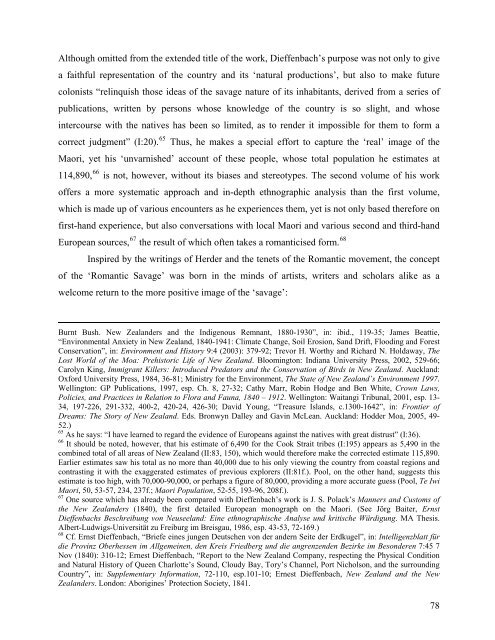General copyright and disclaimer - ResearchSpace@Auckland ...
General copyright and disclaimer - ResearchSpace@Auckland ...
General copyright and disclaimer - ResearchSpace@Auckland ...
You also want an ePaper? Increase the reach of your titles
YUMPU automatically turns print PDFs into web optimized ePapers that Google loves.
Although omitted from the extended title of the work, Dieffenbach’s purpose was not only to give<br />
a faithful representation of the country <strong>and</strong> its ‘natural productions’, but also to make future<br />
colonists “relinquish those ideas of the savage nature of its inhabitants, derived from a series of<br />
publications, written by persons whose knowledge of the country is so slight, <strong>and</strong> whose<br />
intercourse with the natives has been so limited, as to render it impossible for them to form a<br />
correct judgment” (I:20). 65 Thus, he makes a special effort to capture the ‘real’ image of the<br />
Maori, yet his ‘unvarnished’ account of these people, whose total population he estimates at<br />
114,890, 66 is not, however, without its biases <strong>and</strong> stereotypes. The second volume of his work<br />
offers a more systematic approach <strong>and</strong> in-depth ethnographic analysis than the first volume,<br />
which is made up of various encounters as he experiences them, yet is not only based therefore on<br />
first-h<strong>and</strong> experience, but also conversations with local Maori <strong>and</strong> various second <strong>and</strong> third-h<strong>and</strong><br />
European sources, 67 the result of which often takes a romanticised form. 68<br />
Inspired by the writings of Herder <strong>and</strong> the tenets of the Romantic movement, the concept<br />
of the ‘Romantic Savage’ was born in the minds of artists, writers <strong>and</strong> scholars alike as a<br />
welcome return to the more positive image of the ‘savage’:<br />
Burnt Bush. New Zeal<strong>and</strong>ers <strong>and</strong> the Indigenous Remnant, 1880-1930”, in: ibid., 119-35; James Beattie,<br />
“Environmental Anxiety in New Zeal<strong>and</strong>, 1840-1941: Climate Change, Soil Erosion, S<strong>and</strong> Drift, Flooding <strong>and</strong> Forest<br />
Conservation”, in: Environment <strong>and</strong> History 9:4 (2003): 379-92; Trevor H. Worthy <strong>and</strong> Richard N. Holdaway, The<br />
Lost World of the Moa: Prehistoric Life of New Zeal<strong>and</strong>. Bloomington: Indiana University Press, 2002, 529-66;<br />
Carolyn King, Immigrant Killers: Introduced Predators <strong>and</strong> the Conservation of Birds in New Zeal<strong>and</strong>. Auckl<strong>and</strong>:<br />
Oxford University Press, 1984, 36-81; Ministry for the Environment, The State of New Zeal<strong>and</strong>’s Environment 1997.<br />
Wellington: GP Publications, 1997, esp. Ch. 8, 27-32; Cathy Marr, Robin Hodge <strong>and</strong> Ben White, Crown Laws,<br />
Policies, <strong>and</strong> Practices in Relation to Flora <strong>and</strong> Fauna, 1840 – 1912. Wellington: Waitangi Tribunal, 2001, esp. 13-<br />
34, 197-226, 291-332, 400-2, 420-24, 426-30; David Young, “Treasure Isl<strong>and</strong>s, c.1300-1642”, in: Frontier of<br />
Dreams: The Story of New Zeal<strong>and</strong>. Eds. Bronwyn Dalley <strong>and</strong> Gavin McLean. Auckl<strong>and</strong>: Hodder Moa, 2005, 49-<br />
52.)<br />
65 As he says: “I have learned to regard the evidence of Europeans against the natives with great distrust” (I:36).<br />
66 It should be noted, however, that his estimate of 6,490 for the Cook Strait tribes (I:195) appears as 5,490 in the<br />
combined total of all areas of New Zeal<strong>and</strong> (II:83, 150), which would therefore make the corrected estimate 115,890.<br />
Earlier estimates saw his total as no more than 40,000 due to his only viewing the country from coastal regions <strong>and</strong><br />
contrasting it with the exaggerated estimates of previous explorers (II:81f.). Pool, on the other h<strong>and</strong>, suggests this<br />
estimate is too high, with 70,000-90,000, or perhaps a figure of 80,000, providing a more accurate guess (Pool, Te Iwi<br />
Maori, 50, 53-57, 234, 237f.; Maori Population, 52-55, 193-96, 208f.).<br />
67 One source which has already been compared with Dieffenbach’s work is J. S. Polack’s Manners <strong>and</strong> Customs of<br />
the New Zeal<strong>and</strong>ers (1840), the first detailed European monograph on the Maori. (See Jörg Baiter, Ernst<br />
Dieffenbachs Beschreibung von Neuseel<strong>and</strong>: Eine ethnographische Analyse und kritische Würdigung. MA Thesis.<br />
Albert-Ludwigs-Universität zu Freiburg im Breisgau, 1986, esp. 43-53, 72-169.)<br />
68 Cf. Ernst Dieffenbach, “Briefe eines jungen Deutschen von der <strong>and</strong>ern Seite der Erdkugel”, in: Intelligenzblatt für<br />
die Provinz Oberhessen im Allgemeinen, den Kreis Friedberg und die angrenzenden Bezirke im Besonderen 7:45 7<br />
Nov (1840): 310-12; Ernest Dieffenbach, “Report to the New Zeal<strong>and</strong> Company, respecting the Physical Condition<br />
<strong>and</strong> Natural History of Queen Charlotte’s Sound, Cloudy Bay, Tory’s Channel, Port Nicholson, <strong>and</strong> the surrounding<br />
Country”, in: Supplementary Information, 72-110, esp.101-10; Ernest Dieffenbach, New Zeal<strong>and</strong> <strong>and</strong> the New<br />
Zeal<strong>and</strong>ers. London: Aborigines’ Protection Society, 1841.<br />
78















